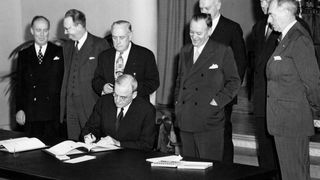Security Treaty between Australia, New Zealand, and the United States of America
THE PARTIES TO THIS TREATY,
REAFFIRMING their faith in the purposes and principles of the Charter of the United Nations and their desire to live in peace with all peoples and all Governments, and desiring to strengthen the fabric of peace in the Pacific Area,
NOTING that the United States already has arrangements pursuant to which its armed forces are stationed in the Philippines, and has armed forces and administrative responsibilities in the Ryukyus, and upon the coming into force of the Japanese Peace Treaty may also station armed forces in and about Japan to assist in the preservation of peace and security in the Japan Area,
RECOGNIZING that Australia and New Zealand as members of the British Commonwealth of Nations have military obligations outside as well as within the Pacific Area,
DESIRING to declare publicly and formally their sense of unity, so that no potential aggressor could be under the illusion that any of them stand alone in the Pacific Area, and
DESIRING further to coordinate their efforts for collective defense for the preservation of peace and security pending the development of a more comprehensive system of regional security in the Pacific Area,
THEREFORE DECLARE AND AGREE as follows:
Article I
The Parties undertake, as set forth in the Charter of the United Nations, to settle any international disputes in which they may be involved by peaceful means in such a manner that international peace and security and justice are not endangered and to refrain in their international relations from the threat or use of force in any manner inconsistent with the purposes of the United Nations.
Article II
In order more effectively to achieve the objective of this Treaty the Parties separately and jointly by means of continuous and effective self-help and mutual aid will maintain and develop their individual and collective capacity to resist armed attack.
Article III
The Parties will consult together whenever in the opinion of any of them the territorial integrity, political independence or security of any of the Parties is threatened in the Pacific.
Article IV
Each Party recognizes that an armed attack in the Pacific Area on any of the Parties would be dangerous to its own peace and safety and declares that it would act to meet the common danger in accordance with its constitutional processes. Any such armed attack and all measures taken as a result thereof shall be immediately reported to the Security Council of the United Nations. Such measures shall be terminated when the Security Council has taken the measures necessary to restore and maintain international peace and security.
Article V
For the purpose of Article IV, an armed attack on any of the Parties is deemed to include an armed attack on the metropolitan territory of any of the Parties, or on the island territories under its jurisdiction in the Pacific or on its armed forces, public vessels or aircraft in the Pacific.
Article VI
This Treaty does not affect and shall not be interpreted as affecting in any way the rights and obligations of the Parties under the Charter of the United Nations or the responsibility of the United Nations for the maintenance of international peace and security.
Article VII
The Parties hereby establish a Council, consisting of their Foreign Ministers or their Deputies, to consider matters concerning the implementation of this Treaty. The Council should be so organized as to be able to meet at any time.
Article VIII
Pending the development of a more comprehensive system of regional security in the Pacific Area and the development by the United Nations of more effective means to maintain international peace and security, the Council, established by Article VII, is authorized to maintain a consultative relationship with States, Regional Organizations, Associations of States or other authorities in the Pacific Area in a position to further the purposes of this Treaty and to contribute to the security of that Area.
Article IX
This Treaty shall be ratified by the Parties in accordance with their respective constitutional processes. The instruments of ratification shall be deposited as soon as possible with the Government of Australia, which will notify each of the other signatories of such deposit. The Treaty shall enter into force as soon as the ratifications of the signatories have been deposited.
Article X
This Treaty shall remain in force indefinitely. Any Party may cease to be a member of the Council established by Article VII one year after notice has been given to the Government of Australia, which will inform the Governments of the other Parties of the deposit of such notice.
Article XI
This Treaty in the English language shall be deposited in the archives of the Government of Australia. Duly certified copies thereof will be transmitted by that Government to the Governments of each of the other signatories.
IN WITNESS WHEREOF the undersigned Plenipotentiaries have signed this Treaty.
DONE at the city of San Francisco this first day of September, 1951.
FOR AUSTRALIA:
[Signed:]
PERCY C SPENDER
FOR NEW ZEALAND:
[Signed:]
C A BERENDSEN
FOR THE UNITED STATES OF AMERICA:
[Signed:]
DEAN ACHESON
JOHN FOSTER DULLES
ALEXANDER WILEY
JOHN J SPARKMAN
Instruments of ratification were deposited for Australia, New Zealand and the United States of America 29 April 1952, on which date the Treaty entered into force






